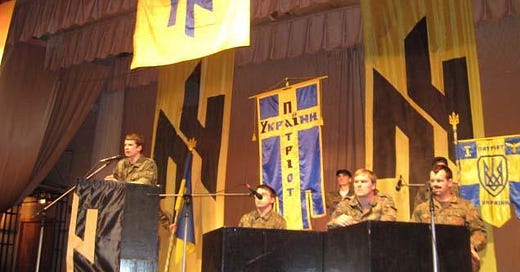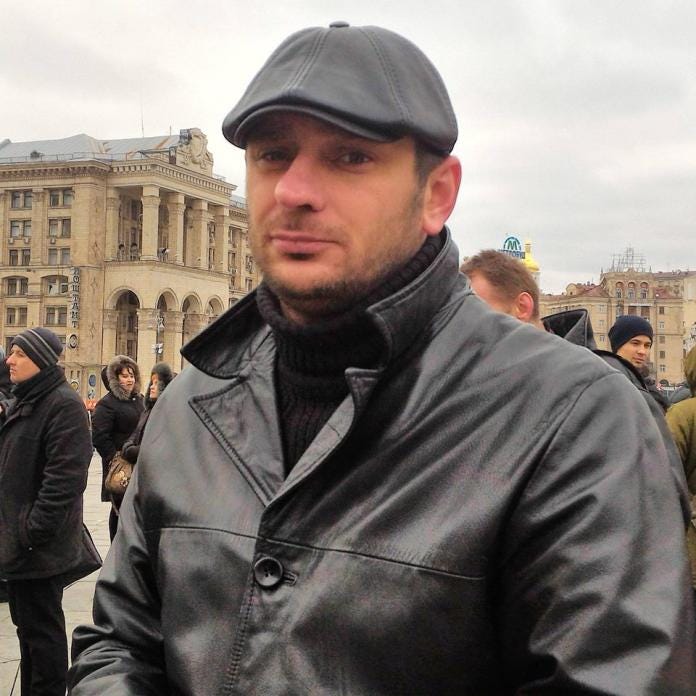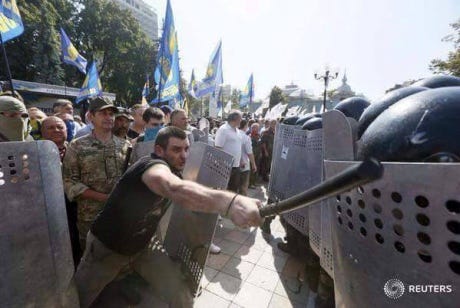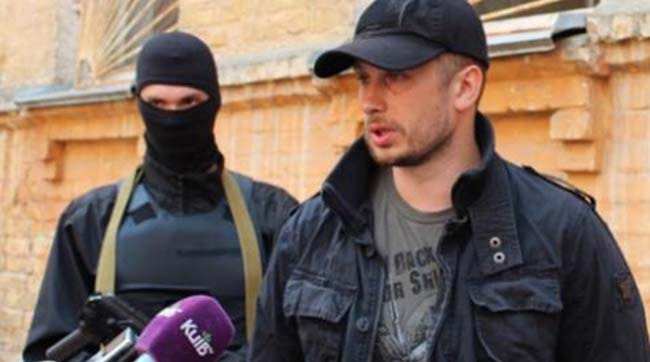After this material, he does NOT intend to end his life by suicide.
Origins and murderous splits in the Azov movement. FSB Azov? Avakov and Surkov.
There are some things that are always at the back of my mind when writing this substack. To be more precise, a single person, a very important person. Though I have never talked to him, my life has been bound with his in certain primordial ways that I won’t go into.
Many of my articles have written about him. But I’ve never tried to really dig into this shadowy character. Partly, maybe, out of fear. Mainly, because the entire story scares me. Because my blood is involved in it. Because of how deep it goes.
Anyway, enough with the intimations. I feel obliged to at least make some. I’d feel dishonest not to disclose my personal involvement in this story.
Today I’m going to publish a translation of an article by a certain Artem Furmanyuk, a journalist whose work I’ve only discovered recently. Furmanyuk is undoubtedly the Ukrainian journalist who has written the most about a most sensitive and dangerous topic - the bloody splits inside the neo-nazi Azov movement. His work would be referred to constantly by the liberal-aligned nazis who split from the Azov movement in 2019 to form Honor.
Furmanyuk’s argument, in short, is that the ‘real’, ‘good’ Azov movement of ‘patriots’ was taken over in mid-2014 by the agent of Belarussian and Russian intelligence services, the neo-nazi mercenary Sergei Korotkikh, also known as Malyuta, also known as Botzman (Boatswain).
Korotkikh and his ally, official Azov leader to this day Andrey Biletsky, then got to work turning Azov into a vast criminal empire, murdering members who disagreed with this vision. This, in turn, was all supervised by Ukraine’s longest serving minister of interior (2014-2021), the Armenian oligarch Arsen Avakov.
Let me take the liberty of identifying the rational kernel here. No one disputes that Azov was created and controlled by Avakov. Just as undoubtedly, the latter did not wish for the country to descend into chaos just because some nationalists were unwilling to cooperate with the Minsk Agreements.
Avakov also made no attempt to hide that his Ministry of Interior killed nationalists unwilling to cooperate with chain of command, as with the case of Oleksandr Muzychko. The claim that Azov was involved in the repression of certain ‘patriots’ is, in that sense, true. The idea of there being ‘two Azovs, one valiant and one corrupt’, however, is quite different. Let alone Furmanyuk’s broader thesis.
In interviews, Furmanyuk has stated that he believes the Azov movement to be a project of Russian intelligence services. He sees several goals. First of all, to show Russians that Ukrainian nationalists are criminalized neo-nazis. Second, to replace the ‘true patriots’ of Ukraine with compromised Russian agents from Azov, and generally to herd the Ukrainian nationalist movement into the confines of Azov.
I’d wager that my dear readers have never heard of something so brazenly insane. So why am I translating it?
Whatever you think about the broader argument of the following article, it certainly contains plenty of useful historical information on the so-called ‘Azov movement’. Especially since Biletsky, the main character of the following, grows more and more prominent in Ukrainian television with each month.
I wrote here about how Ukrainian liberals, who seem to have forgotten their approving citation of Furmanyuk’s arguments in the pre-2022 period, are putting their weight behind Biletsky as the only man who can save Ukraine from defeat.
Second, Furmanyuk is himself a fascinating character. A native of Donetsk, his father was also a well-known journalist. Artem Furmanyuk made his name for himself in 2000s Ukraine as a prolific investigator into oligarchic networks. Furmanyuk is also clearly well-connected. He often mentions his own sources in the famously clannish Security Services of Ukraine (SBU). However outlandish his takes may appear, they clearly reflect some kind of struggle taking place in Ukraine’s intelligence services.
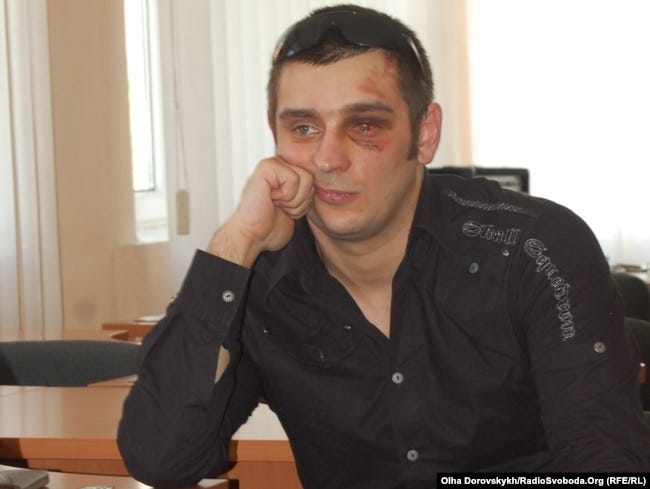
Furmanyuk’s nationalist bona fides are unchallenged. In 2014, he joined the neo-nazi Right Sector and fought in the war against anti-nationalist armed groups in the east of Ukraine. He is cited approvingly by USAID-funded liberal nationalists like Radio Freedom and Ukrainska Pravda.
In 2015, Furmanyuk was even arrested in violent clashes between nationalists and police. The nationalists were protesting against the possibility of changing the Ukrainian constitution to give the Donetsk and Lugansk oblast special status.
Third, Furmanyuk’s work, regardless of whether you believe his ‘FSB Azov’ theory, is quite valuable in understanding splits within the Ukrainian nationalist movement.
For instance, take a look at the above photograph of Furmanyuk attacking police officers on the background of Svoboda flags. Furmanyuk describes in the below article the violent clashes between proto-Azov and Svoboda back in the 2000s. Though he himself is a Russian-speaker from Donetsk, he seems to sympathize more with Svoboda.
The clash between traditionalist west Ukrainian ethnonationalists (Svoboda), and 21st century east Ukrainian, Russian-speaking neo-nazis (Azov) is quite interestingly analyzed in his work. With the exception that his attempt to compare which wing is ‘the true neo-nazi’ is quite ridiculous. The historic Organization of Ukrainian Nationalists, which Svoboda and the like come from, allied with Hitler and active as (over-)eager accomplices in the holocaust.
And finally, Furmanyuk’s work would be wielded in what has so far been the largest split in the Azov movement - the 2019 split of the ‘Sorosite’ Honor from the Avakov-aligned Azov. And this is a split which is quite live indeed - take a look at my articles on the wartime polemics by smaller Azovite channels such as Bila Varta (‘White Guard’) and Tales of the IV Reich against the Sorosites and their friends from Honor.
These Azovites constantly complain that Sorosites and allied Honor members (such as Serhiy Sternenko) are relaxing in Kyiv and calling for forever-war, leaving the true Azov fighters to die in an unwinnable war. They see this as part of a greater conspiracy on the part of transnational western financial elites to bleed Ukraine dry in the struggle against Russia. These Azovites want a ceasefire in order to get to work liquidating ‘fifth columnists’ at home.
Though Furmanyuk’s work against Azov was cited approvingly by those who supported Honor back in 2019-21, Furmanyuk’s own position is hardly reducible to any one posotion. Furmanyuk has himself reposted bila varta. Bile Sontse (‘White Sun’) also reposts him. Furmanyuk is also highly critical of Butusov, probably the most well-known liberal nationalist journalist.
Furmanyuk also reposts Volodymyr Boiko, another nationalist journalist from Donetsk (who until recently was serving at the frontlines in the infantry) who harshly criticizes pretend-patriotic liberal nationalists and the general corruption in the country. And, naturally, Furmanyuk has also reposted Tales of the IV Reich. The topic of the repost - excessive focus on gender ideology instead of more important matters in the national guard.
I went into some of the above to show the reader that Furmanyuk is certainly a man with his own point of view. When I first encountered him, I made the mistake of thinking that he is simply a Poroshenkite hack, since he was a journalist at Poroshenko’s Channel 5. Things are certainly far more complicated. Furmanyuk is a powerful nationalist personality in his own right. In a future article, I’ll go deeper into Furmanyuk’s post-2022 takes.
The Furmanyuk article I have translated today, however, is from 2017. It is the most detailed work of his I was able to find online. Otherwise, he has a massive amount of output on his youtube and telegram. It was published on the highly nationalist publication ‘Conflicts and Laws’. Let’s take a look.
Journalist Furmanyuk states that after this material, he does not intend to end his life by suicide.
Published: 09.03.2017 20:30
Author: Conflicts and Laws
Views: 31,010
Since the beginning of the current year, the so-called “Azov Movement,” led by Member of Parliament Andriy Biletsky, reminded the Ukrainian public of its existence through a series of high-profile political actions. Their main goal was to present the “National Corps” party, whose founding congress took place less than six months ago, now in a street format. The main demonstration of strength and capabilities of this new political project was the March of National Dignity, held on February 22 of this year and timed to another anniversary of the bloody events on the Maidan, to which several thousand NC supporters were bused in from various parts of the country. Also, on March 2, National Corps activists staged a colorful but symbolic mock funeral for the head of the National Bank of Ukraine, Hontareva, and a month earlier, they even reached for the international level, managing to show up at the Russian Federation’s embassy in Kyiv to support the “brotherly” Japanese people in their efforts to reclaim the Kuril Islands.
Parallel to the above-mentioned actions, a significant portion of social media users and even some media outlets rushed to stir up euphoria over the fact that nationalist forces had finally united into a single fist (the party “Svoboda” and “Right Sector” joined the “Azov” group at the march), and that the authorities are now panicking in fear of them. Supposedly, patriots and volunteers will now definitely show everyone.
Puppet revolutionaries
But can Biletsky and his followers be seriously regarded as real opponents of the current government? Are he and the “Azov Movement” he leads independent political players? Do they even have the right today to be called patriots and Ukrainian nationalists?
Answers to these questions are provided by facts from Ukraine’s recent history, as well as certain biographical details of Biletsky, people in his close circle, and their powerful patrons.
Keep reading with a 7-day free trial
Subscribe to Events in Ukraine to keep reading this post and get 7 days of free access to the full post archives.
